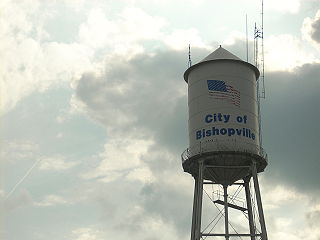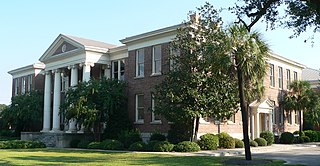
Bishopville is a town in Lee County, South Carolina, United States. The population was 3,471 at the 2010 census. It is the county seat of Lee County.
Lee Academy, formerly Robert E. Lee Academy, is a co-educational private school in Bishopville, South Carolina, United States. It was established in 1965 as a segregation academy and continued to serve an overwhelmingly white student body in the 2000s, with only three black students among a student body of more than 250 in 2018.

The Lee County Courthouse, built in 1908, is a historic courthouse located at 123 S. Main Street in the city of Bishopville in Lee County, South Carolina. It was designed in the Classical Revival style by Darlington native William Augustus Edwards who designed eight other South Carolina courthouses as well as academic buildings at 12 institutions in Florida, Georgia and South Carolina. Lee County was created in 1902 and this is the only courthouse it has ever had.
William Augustus Edwards, also known as William A. Edwards was an Atlanta-based American architect renowned for the educational buildings, courthouses and other public and private buildings that he designed in Florida, Georgia and his native South Carolina. More than 25 of his works have been listed on the National Register of Historic Places.

The U.S. Department of Agriculture Administration Building, also known as the Jamie L. Whitten Building, houses the administrative offices of the U.S. Department of Agriculture in Washington, D.C. The Administration Building projects into the National Mall from the larger U.S. Department of Agriculture South Building, and is the only building on the Mall that is not intended for use by the general public. It was the first large Beaux-Arts style building in Washington and set the prototype for the later buildings of the Federal Triangle. The east and west wings were the first Federal office buildings to be built of reinforced concrete. The Whitten Building was listed on the National Register of Historic Places in 1974.

Mt. Zion Presbyterian Church is a historic Presbyterian church located near Bishopville Lee County, South Carolina. It was built in 1911, and is a linear gable-front, temple-form, two-story brick building in the Neoclassical style. Set upon a raised brick foundation, the building's most imposing feature is its tetrastyle portico featuring a full-width masonry stair with cheek walls and monumental limestone columns and pilasters of the Ionic order. Directly to the rear of the church building is a small, one-story lateral-gabled frame building, constructed in 1851 as Mt. Zion's Session House.

The Greenfield Union School is a school located at 420 West 7 Mile Road in Detroit, Michigan. A part of Detroit Public Schools (DPS), the school building was listed on the National Register of Historic Places in 2011.

Memorial Hall, also known as the General Service Building, is a historic dormitory building located on the campus of Coker University at Hartsville, Darlington County, South Carolina. It was built in two phases in 1913 and 1916. Memorial Hall is a three-story, five-bay, masonry building with Neo-Classical details. The front façade features a three-bay projecting full-height portico supported by four colossal Corinthian order columns. In 1916, the General Service Building was added and consists of three distinct parts: a central projecting block and two dormitory wings. It was built with funds donated by the college's founder, Major James Lide Coker.

Winyah School, also known as Winyah Graded and High School, Georgetown Graded & High School, and Old Winyah School, is a historic school building located at Georgetown, Georgetown County, South Carolina. It consists of a 1908 Classical Revival style school building and auditorium, with an auditorium extension and high school addition built about 1924. It has a raised masonry and concrete foundation and low hipped roof.

Dennis High School, also known as Dennis Elementary School and Dennis Primary School, is a historic high school building for African-American students located at Bishopville, Lee County, South Carolina. White students attended Bishopville High School, three blocks away. Although the law provided for a separate but equal education, $71,000 was allocated to build Bishopville for the whites while only Dennis was built for $17,000. The expenditures for student at BHS were $48.38 per student, but only $5.68 for each Black student at Dennis. When Dennis High School later burned down, the Black students were just made to double up with the elementary students for 12 years. Dennis was the only school in the county for black students, and no public bus service was provided until 1952.

James Carnes House, also known as "The Myrtles," is a historic home located at Bishopville, Lee County, South Carolina. It was built about 1836, and is a two-story, Greek Revival style frame house. It has a gable roof, weatherboard siding, brick foundation and stuccoed exterior end brick chimneys. The house features a large, two-story, pedimented portico on the front façade, with four larger square, frame columns with Doric order motif capitals. A large 1+1⁄2-story addition was added to the rear about 1900, when the house was made into a boarding house.

William Apollos James House is a historic home located at Bishopville, Lee County, South Carolina. It was built in 1903, as a one-story, Folk Victorian cottage with a center gabled dormer. It was enlarged and altered in 1911, in the Colonial Revival style, with the addition of a second story with hipped roof, and a hip-roofed wraparound porch. It was the home of William Apollos James (1857–1930), prominent state representative, agriculturalist, businessman, and community leader of Lee County. Also on the property is a collection of historic and interesting flora in its ornamental and fruit garden, along with mature trees and shrubs. The house serves as the headquarters for the Lee County Historical Society.

William Rogers House, also known as Tindal House, is a historic home located at Bishopville, Lee County, South Carolina. It was built about 1845, and is a two-story, vernacular Greek Revival style house. The front façade features a large two-story pedimented portico. This portico has four large square, frame columns with Doric order capitals. William Rogers' grandson was Thomas G. McLeod, who served as South Carolina's governor from 1923 to 1927. During his childhood McLeod was a frequent visitor to this home.

The Manor, also known as The Tisdale House, now The Cullifer Manor is an historic home located at Bishopville, Lee County, South Carolina. It was built between 1914 and 1918, and is a two-story, rectangular Neoclassical style brick dwelling. It has a gable roof and two interior brick chimneys. On the front façade is a free-standing, two-story portico with six wooden Corinthian order columns, and a balustrade, and decorative railing along the roofline. Also on the property are two original, one-story brick, hip-roofed buildings which serve as a garage and storage area for the main house.
Bishopville Commercial Historic District is a national historic district located at Bishopville, Lee County, South Carolina. It encompasses 48 contributing buildings in the central business district of Bishopville. All of the commercial buildings are of brick construction with most constructed between 1890 and 1920. All of the buildings are used for commercial purposes such as stores, restaurants, offices and banks. Two important buildings are the Seaboard Coastline Depot and the Palmetto Oil Mill.
South Main Historic District is a national historic district located at Bishopville, Lee County, South Carolina. It encompasses 11 contributing buildings in a residential section of Bishopville. They were constructed between about 1880 and 1925, and is the best remaining concentration of historic residential architecture in Bishopville. The district contains a fine grouping of late-19th and early-20th century residences reflecting the vernacular Queen Anne, Colonial Revival and Bungalow styles.

Ashwood School Gymnasium and Auditorium is a historic school gymnasium and auditorium located at Ashwood near Bishopville, Lee County, South Carolina. It was built in 1938 to serve Ashwood Plantation, the first and largest of the Resettlement Administration (RA) project tracts in South Carolina. The building served as the school and community gymnasium and as an auditorium for dramatic performances and films. It is a one-story building with a simplified Colonial Revival style popular in the 1930s in government-sponsored construction.

The Plummer-Motz School, formerly Falmouth High School, is a former school building at 192 Middle Road in Falmouth, Maine. Built in the 1930s, it was the town's first high school, serving as first a high school, and later as a junior high school and elementary school, until its closure in 2011. The building has been converted to residential use.

The Old Waterville High School, also known historically as the Gilman Street School, is a former school building at 21 Gilman Street in Waterville, Maine. Opened in 1912 and enlarged in the 1930s with Works Progress Administration funding, it is locally distinctive for its Collegiate Gothic and Art Deco architecture, and for its importance to the city's education system. The building, now converted to residences, was listed on the National Register of Historic Places in 2010.

Rapid City High School (RCHS), formerly the Dakota Junior High School and then the Dakota Middle School, is an alternative high school at 601 Columbus Street, Rapid City, South Dakota. Established in 1923, the building served as the first site of Rapid City Central High School until it moved to a new facility on Mount Rushmore Road North. Rapid City High School also hosts the Performing Arts Center of Rapid City. The school building was listed on the National Register of Historic Places on June 28, 2010.




















